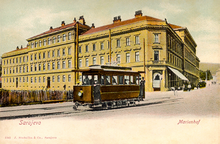|
Trams in Sarajevo
Trams in Sarajevo are a part of the public transport system in Sarajevo, the capital city of Bosnia and Herzegovina. The system is run by KJKP GRAS Sarajevo, which also operates trolleybus and bus routes in the city. As of 2010, the Sarajevo tram system consists of seven lines,[1][2] running along a single route with a 0.4 kilometres (0.25 mi)-long branch to the city's main railway station (Željeznička Stanica). It primarily serves as an east-west link from the city centre (Baščaršija) to the western suburb of Ilidža. History  Opened on New Year's Day in 1885,[citation needed] the Sarajevo tramway was the testing line for the tram in Vienna and the Austro-Hungarian Empire, and operated by horses. Originally built to 760 mm (2 ft 5+15⁄16 in) Bosnian gauge, the present system was upgraded to 1,435 mm (4 ft 8+1⁄2 in) standard gauge in 1960. The trams played a pivotal role in the growth of the city in the 20th century.[3] During the Siege of Sarajevo of 1992-1995, trackwork and numerous vehicles were badly damaged. The tram operation stopped on 15 April 1992, 9 days after the siege started, and resumed despite the dangers of the ongoing siege on 15 April 1994.[4] The vehicles are once again operational though marks remain on some vehicles. System
The route lies on the main boulevard of Sarajevo, which is named (from west to east) first Bulevar Meše Selimovića (formerly 6 Proleterske Brigade), from Vila Čengić then Zmaj od Bosne (formerly Vojvode Radomira Putnika). From the district Marijin Dvor it runs a loop in a counter-clockwise direction along the Miljacka river on the street called Obala Kulina bana (formerly: Obala Vojvode Stepe Stepanovića). It proceeds to the terminus Baščaršija. The route then turns back towards Marijin Dvor on the northern parallel road Maršala Tita. Seven routes are presently in operation on the system, often only a specific section of the track. Only Route 3 operates the entire length.
In the early 1990s, construction work started to expand the tram network from Nedžarići to Dobrinja, which was at the time served by a trolleybus system. Work stopped in 1992 when the siege started, which was also when most of the vehicles and infrastructure was damaged. At Nedžarići, it is possible to see tracks leading towards a planned, but never finished boulevard that would link towards Dobrinja. No work has been done in the said neighborhood to prepare access of trams there due to the start of the war, so these are the only traces of the planned extension. Rolling stockIn 1958, Sarajevo bought 50 relatively modern PCC streetcars from Washington, renumbered in the 1-50 series. Another 21 more Washington PCCs followed in 1962, numbered 51-71. These 71 PCCs were built between 1941 and 1944 by the St. Louis Car Company. Between 1967 and 1969, 20 of these streetcars were reconstructed into ten articulated cars and renumbered 100-109.[citation needed] The fleet in use on the network are Tatra K2 articulated trams from the Czech Republic, delivered in the 1970s and early 1980s. Later these trams were joined by more modern vehicles in recent times. In 2008, Amsterdam donated 16 old trams to Sarajevo.[citation needed] In September 2021, Stadler was awarded a contract to supply 15 Tango NF3 trams to the city.[5] The first vehicle was unveiled at the 15th Trako International Railway Fair on 20 September 2023.[6] The first tram arrived in December 2023, while the rest are expected to arrive by the summer of 2024.[7] An additional 10 new trams were also bought.[8] Gallery
See alsoWikimedia Commons has media related to Tram transport in Sarajevo. ReferencesFootnotes
Bibliography
External links |
|||||||||||||||||||||||||||||||||||||||||||||||||||||||||||||||||||||||||||||||||||||||||||||||||||||||||||||||||||||||||||||||||||||||||||||||||||||||||||||||||||||||||||||||||||||||||||||||||||||||||||||||||||||||||||||||||||||||||||||||||||||||||||||||||||||||||||||||||||||||||||||||||||||||||||||||||||||||||||||||||||||||



































